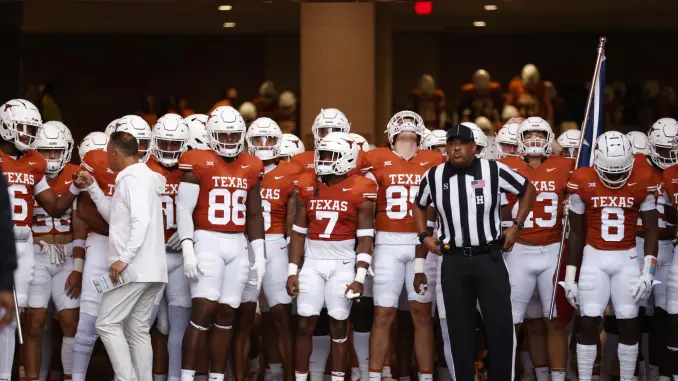Title: Texas Athletics Breaks Records in Revenue and Expenses in 2024: A Game-Changer for College Sports
In 2024, Texas Athletics achieved a remarkable financial feat, setting both revenue and expense records that are poised to reshape the landscape of college athletics. As one of the most prominent athletic programs in the nation, Texas Athletics has long been a dominant force in sports, but its performance in 2024 has proven that the department’s success is not just measured on the field or court—it’s also reflected in its financial prowess. The unprecedented revenue figures, coupled with the record-setting expenses, tell a compelling story of investment, growth, and the increasing commercialization of college sports.
Record-Breaking Revenue for Texas Athletics
In the fiscal year 2023, Texas Athletics reported an astonishing total revenue of over $271 million, setting a new benchmark for college sports. This revenue was generated through various streams, with football, basketball, and other major sports driving a significant portion of the gains. The performance of Texas’ football team was one of the central pillars of this success. The Longhorns’ strong season, which included a Big 12 championship win and an appearance in the College Football Playoff, catapulted ticket sales, media rights deals, and merchandise revenue to all-time highs.
Football, as expected, was the primary driver of Texas Athletics’ revenue, accounting for more than $183 million in operating income alone. This success not only reflects the on-field achievements but also the growing influence of television rights and sponsorship deals. With the increasing commercial value of the sport, media partnerships have become an essential source of income for universities, and Texas Athletics capitalized on this to the fullest.
In addition to football, other sports also contributed to the department’s record-breaking earnings. Texas men’s basketball, which saw a surge in popularity thanks to a strong season, was instrumental in driving ticket sales and merchandise purchases. The new $375 million Moody Center, which opened in 2024, played a pivotal role in boosting basketball revenue, hosting a variety of events beyond just basketball, including concerts and other entertainment. Its state-of-the-art facilities have made it a premier venue for events, contributing to a significant uptick in revenue.
Texas Athletics has also seen a rise in sponsorships and donations, driven in part by the strategic expansion of its marketing and fan engagement efforts. With alumni and fans increasingly invested in the success of the programs, the department was able to secure substantial contributions to its operating budget.
The Rising Cost of College Athletics
While the revenue numbers were extraordinary, they came with an equally significant increase in expenses. Texas Athletics spent a record $232.3 million in fiscal year 2023, an increase of over $7 million from the previous year. This surge in spending reflects the department’s commitment to maintaining its position as one of the elite athletic programs in the country.
A substantial portion of the budget was allocated toward the football program, which saw an increase in expenditures from $51.5 million to $61 million in fiscal year 2023. This increase was primarily driven by rising costs associated with recruiting, facility upgrades, and player development programs. As the stakes in college athletics continue to rise, so too does the need for investments in state-of-the-art training facilities, advanced analytics, and top-tier coaching staff. Texas Athletics has also poured resources into enhancing the overall student-athlete experience, providing resources for health, nutrition, and academic support.
One of the most notable expense categories for Texas Athletics in 2024 was its commitment to improving facilities. The opening of the Moody Center, which replaced the Frank Erwin Center, was a significant investment in Texas Basketball. This state-of-the-art venue has not only improved the fan experience but also created new revenue streams from a variety of events hosted there. However, the cost of building and maintaining such a facility has added millions to the athletics department’s expenses.
Furthermore, the increasing salaries of coaches, particularly in football and basketball, have been a driving factor in rising costs. As competition in college sports intensifies, schools must pay top dollar to secure the best talent. The Longhorns’ head football coach, for instance, signed a contract extension that included a salary increase and additional performance bonuses. These kinds of investments in coaching talent are becoming more common across the country as schools seek to remain competitive in an ever-changing collegiate sports landscape.
Economic Impact of Texas Athletics
Beyond the financial records of the department itself, Texas Athletics has had a profound economic impact on the Austin area and the state of Texas. According to an economic impact study conducted by Angelou Economics, the total economic contribution of Texas Athletics exceeded $728 million in 2024. This includes direct spending on events, salaries, and procurement, as well as indirect spending in the local economy, including restaurants, hotels, and retail businesses that benefit from the influx of fans and tourists for major games.
The economic impact of Texas Athletics goes far beyond just the immediate financial benefits for the university. The jobs created by the athletic program, both on-campus and throughout the local community, are a critical part of the state’s economy. From game-day staff to vendors, security personnel, and marketing professionals, the athletics department’s spending reverberates throughout the local and regional economy.
Moreover, the increase in revenue and the positive publicity surrounding Texas Athletics also has a significant impact on the university’s broader financial health. With a robust athletics program, Texas is able to attract top-tier students and faculty, engage with alumni, and enhance its brand identity both domestically and internationally.
The Role of Name, Image, and Likeness (NIL)
Another factor that contributed to both revenue and expense growth for Texas Athletics in 2024 was the continued evolution of the Name, Image, and Likeness (NIL) landscape. NIL deals have transformed the way college athletes engage with brands and earn compensation. The University of Texas has been at the forefront of these changes, with a growing number of athletes signing endorsement deals with major companies.
Texas has actively worked with NIL collectives, organizations that support athletes in securing these types of deals. These collectives play a key role in enhancing the financial standing of Texas athletes, which in turn adds to the overall revenue of the athletics department. However, NIL agreements also add to expenses, as the university must allocate resources to ensure that athletes are supported with legal and marketing teams to manage their deals.
The integration of NIL into the athletics landscape has also led to increased competition among schools to attract top-tier talent. As a result, universities like Texas have had to increase their financial investments not only in sports programs and facilities but also in NIL infrastructure.
Looking Ahead: Sustaining Success
The records set by Texas Athletics in 2024 are not simply a one-off achievement—they are a reflection of a strategic, long-term vision for the future of college sports. As the department continues to build on its success, the focus will be on sustaining this financial growth while ensuring that the student-athlete experience remains at the core of its mission.
Moving forward, Texas Athletics plans to expand its investments in both facilities and coaching staff to remain competitive at the highest level. With the rise of NIL deals and the growing influence of media rights, the university is also working to develop new revenue streams to support its athletes and programs.
While the increased expenses may raise concerns about the sustainability of such financial growth, the financial success of Texas Athletics in 2024 provides a strong foundation for the future. With a dedicated fan base, top-tier athletic programs, and a commitment to excellence, Texas Athletics is poised to continue its record-breaking performance in the years to come.
Conclusion
The historic revenue and expense records set by Texas Athletics in 2024 highlight the increasing financial power of college sports. Texas’ athletic programs have become more than just a source of pride for the university—they are now a critical economic engine that drives growth and opportunity for the entire region. As the collegiate sports landscape evolves, Texas Athletics has positioned itself as a leader in both athletic excellence and financial achievement. The success of the program in 2024 serves as a blueprint for other schools seeking to capitalize on the opportunities presented by the ever-growing world of college sports.



